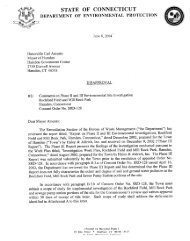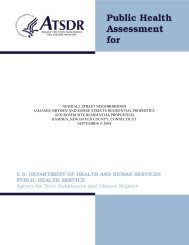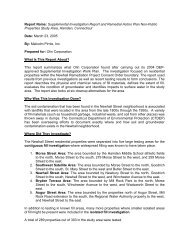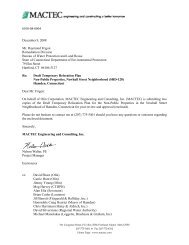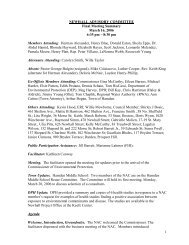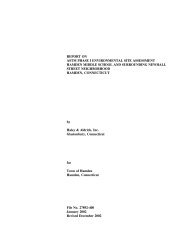Remedial Action Plan - Rochford Field - Newhall Remediation Project
Remedial Action Plan - Rochford Field - Newhall Remediation Project
Remedial Action Plan - Rochford Field - Newhall Remediation Project
Create successful ePaper yourself
Turn your PDF publications into a flip-book with our unique Google optimized e-Paper software.
4. SOIL REMEDY<br />
4.1 Overview<br />
In accordance with Alternative 4 outlined in Section 3, proposed remedial measures to be used at<br />
<strong>Rochford</strong> <strong>Field</strong> include construction of an engineered control (EC), placement of an ELUR to restrict<br />
access to soil below the EC, and natural attenuation groundwater monitoring. The following sections<br />
address the remedial strategies will be used to bring <strong>Rochford</strong> <strong>Field</strong> into compliance with the RSRs.<br />
An overview of the proposed site design for <strong>Rochford</strong> <strong>Field</strong> is shown in Figure 3. The site design<br />
includes baseball and little league fields, landscaped areas and an entrance gate. A detailed profile view<br />
is shown on Figure 4. <strong>Plan</strong> notes and details are shown on Figure 5.<br />
4.2 Engineered Control Design and Construction<br />
Section 22a-133k-2(f)(2) of the RSRs permits the use of an engineered control (EC) to physically isolate<br />
polluted soil from direct exposure to humans and/or infiltrating storm water from polluted soil to<br />
protect groundwater quality. CTDEEP published a “Guidance Document, Engineered Controls<br />
pursuant to Section 22a-133k-2(f) of the Connecticut <strong>Remediation</strong> Standard Regulations” dated<br />
February 2009 and revised November 2010. This guidance document describes an engineered Control<br />
as:<br />
A permanent physical structure designed to safely isolate pollutants which would<br />
otherwise not comply with the self-implementing remedial options allowed in sections<br />
22a-133k-1 through -3 of the <strong>Remediation</strong> Standard Regulations (RSRs). An EC is a<br />
“variance” which requires the Commissioner’s approval. It generally contains<br />
inspection, maintenance and reporting requirements, the recording of an Environmental<br />
Land Use Restriction (ELUR), and the posting of financial assurance to ensure such<br />
measures will be sustained into the future.<br />
In accordance with 22a-133k-2(f)(2)(A)(iv), CTDEEP requires a variance to construct a direct exposure<br />
EC to prevent direct human contact with polluted soil. In the 2007 Remedy Selection <strong>Plan</strong>, CTDEEP<br />
has requested, and as such, approved construction of an EC at the subject site.<br />
4.2.1 Overview<br />
The EC will be necessary to address RDEC and PMC compliance through the physical isolation<br />
of polluted soil. The EC will include an impermeable membrane and 2 ft of fill material; the<br />
EC design is shown in Figures 4 and 5 and described in the following section. Generally, the<br />
EC will be constructed with a gravel layer (above the impermeable liner) to facilitate drainage,<br />
graded to promotes runoff, resistant to erosion, and designed to account for settlement. The<br />
EC design will be locally modified to include:<br />
<br />
<br />
Shallow rooted trees with approximately 90 percent of root mass within two feet of the<br />
ground surface and no tap root (see Figures 4, 5 and 6);<br />
Footings for a retaining wall and sidewalk to be constructed along the perimeter of the<br />
site (see Figures 4 and 5).<br />
15



